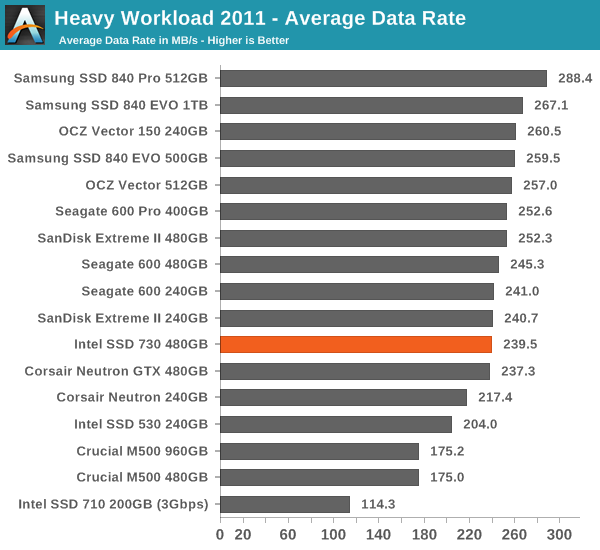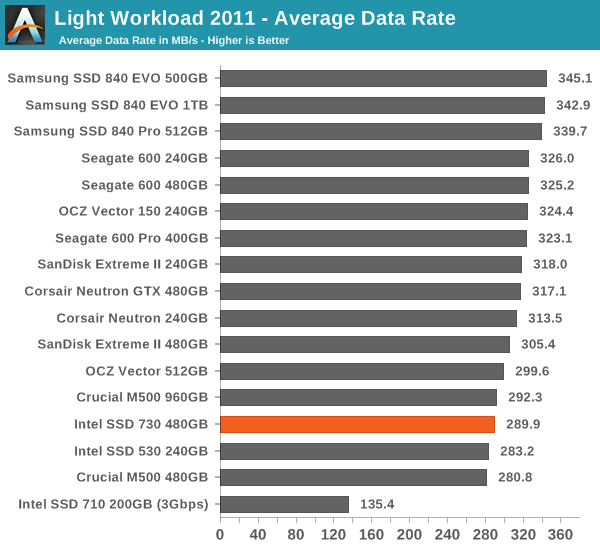Intel SSD 730 (480GB) Review: Bringing Enterprise to the Consumers
by Kristian Vättö on February 27, 2014 12:00 PM EST- Posted in
- Storage
- SSDs
- Intel
- Intel SSD 730
AnandTech Storage Bench 2011
Back in 2011 (which seems like so long ago now!), we introduced our AnandTech Storage Bench, a suite of benchmarks that took traces of real OS/application usage and played them back in a repeatable manner. The MOASB, officially called AnandTech Storage Bench 2011 - Heavy Workload, mainly focuses on peak IO performance and basic garbage collection routines. There is a lot of downloading and application installing that happens during the course of this test. Our thinking was that it's during application installs, file copies, downloading and multitasking with all of this that you can really notice performance differences between drives.
We tried to cover as many bases as possible with the software incorporated into this test. There's a lot of photo editing in Photoshop, HTML editing in Dreamweaver, web browsing, game playing/level loading (Starcraft II & WoW are both a part of the test) as well as general use stuff (application installing, virus scanning). We've included a large amount of email downloading, document creation and editing as well. To top it all off we even use Visual Studio 2008 to build Chromium during the test.
The test has 2,168,893 read operations and 1,783,447 write operations. The IO breakdown is as follows:
| AnandTech Storage Bench 2011 - Heavy Workload IO Breakdown | ||||
| IO Size | % of Total | |||
| 4KB | 28% | |||
| 16KB | 10% | |||
| 32KB | 10% | |||
| 64KB | 4% | |||
Only 42% of all operations are sequential, the rest range from pseudo to fully random (with most falling in the pseudo-random category). Average queue depth is 4.625 IOs, with 59% of operations taking place in an IO queue of 1. The full description of the test can be found here.
AnandTech Storage Bench 2011 - Heavy Workload

AnandTech Storage Bench 2011 - Light Workload
Our light workload actually has more write operations than read operations. The split is as follows: 372,630 reads and 459,709 writes. The relatively close read/write ratio does better mimic a typical light workload (although even lighter workloads would be far more read centric). There's lots of web browsing, photo editing (but with a greater focus on photo consumption), video playback as well as some application installs and gaming.
The I/O breakdown is similar to the heavy workload at small IOs, however you'll notice that there are far fewer large IO transfers.
| AnandTech Storage Bench 2011 - Light Workload IO Breakdown | ||||
| IO Size | % of Total | |||
| 4KB | 27% | |||
| 16KB | 8% | |||
| 32KB | 6% | |||
| 64KB | 5% | |||

Again, the SSD 730 comes up with relatively uninspiring performance in this lighter, older workload. If your usage patterns are relatively tame, a drive designed for enterprise usage scenarios may be more than you need and may actually end up performing slower than "lesser" drives in day-to-day use—not that you'd likely notice, as most decent SSDs are now at the point where to normal users they're all plenty fast.










96 Comments
View All Comments
wpcoe - Monday, December 8, 2014 - link
I bought the 240GB version at Fry's last Thursday for US$98.00. I figure that at 40¢/GB how bad can it be.amddude10 - Thursday, November 27, 2014 - link
Why does Intel list this as not having "enhanced power loss protection" for either size of the drive? I found no mention of power loss protection on Intel's own product information listing for this. By contrast, the listings for the old 320, S3500, and S3700 show that they do have "enhanced power loss protection." This article states that the 730 has "similar" power loss protection to the S3700, so why isn't this listed on the intel product info page for the 730? This isn't another case of a company letting reviewers believe something other than what is the case, is it? Here's the link: http://ark.intel.com/products/81039/Intel-SSD-730-...mohaba - Friday, December 19, 2014 - link
I'm curious to know the same thing. Every review across the internet mentions that feature, as well as the lack of encryption support and using HET nand, yet the intel documentation is exactly the opposite. I see intel did a documentation update in december.Kob - Saturday, February 27, 2016 - link
The critical difference between the info provided in this current review and Intel's own specs athttp://ark.intel.com/products/81039/Intel-SSD-730-...
regarding enhanced power-loss protection and encryption support diminishes the the trust in Intel public information and reviews in generals.
See what Intel had to say on this in early 2015, and even after that they did not change their official specs as on 2/27/16. What gives?
http://www.hardwarecanucks.com/news/storage-news/r...
NvidiaWins - Saturday, June 20, 2015 - link
Intel is the only SSD manufacturer that didn't fail the stress test, every other SSD vendor FAILED miserably!! http://www.extremetech.com/computing/173887-ssd-st...I own 3 of the 520 series Cherryville 240GB's, 2 are almost 3 years old and still @100% life.
The Gambler - Wednesday, August 12, 2015 - link
Hmm. I did put my 730 into a laptop. But considering how power hungry my laptop is anyway, it pretty much stays plugged in all the time.I could use it on my other PC, but that's a 10-year old Dell Dimension that recently got an HDD upgrade for archival purposes. No use there really.